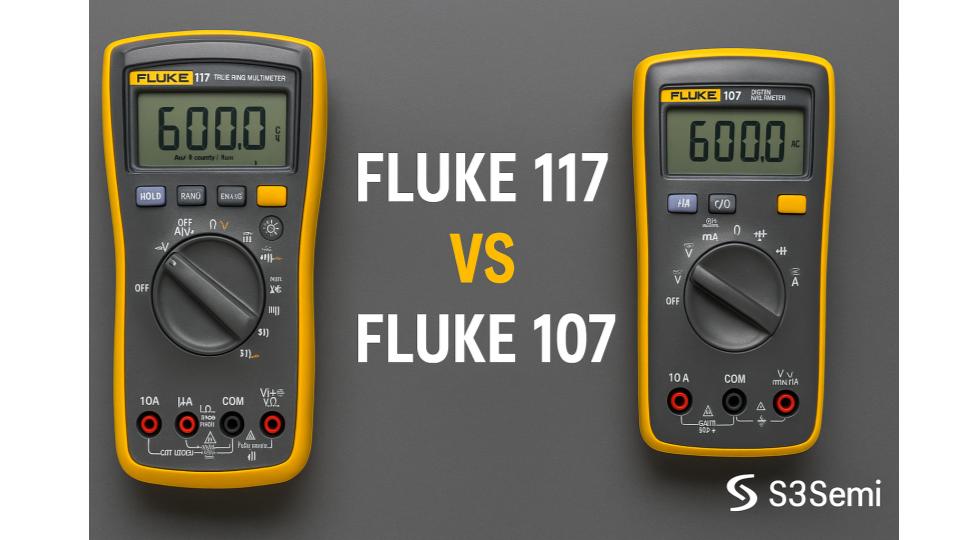Fluke is known for producing reliable and accurate multimeters trusted by electricians, engineers, and technicians worldwide. Two popular models that often get compared are the Fluke 117 and the Fluke 107. Both are compact, handheld multimeters, but they’re designed for slightly different audiences and use cases.
🏷️ Fluke Multimeter Deals ⭐⭐⭐⭐
Let’s take a closer look.
📊 Comparison Table: Fluke 117 vs Fluke 107
| Feature | Fluke 117 | Fluke 107 |
|---|---|---|
| True-RMS | ✅ | ✅ |
| Voltage Measurement | AC/DC | AC/DC |
| Current Measurement | AC/DC | AC/DC |
| Resistance, Continuity, Capacitance | ✅ | ✅ |
| Frequency Measurement | ✅ | ✅ |
| Non-Contact Voltage Detection (VoltAlert) | ✅ | ❌ |
| LoZ (Low Input Impedance) | ✅ | ❌ |
| AutoVolt (Automatic AC/DC Selection) | ✅ | ❌ |
| Backlight | ✅ | ✅ |
| Size & Portability | Medium | Compact (more pocketable) |
| Safety Rating | CAT III 600V | CAT III 600V |
| Target User | Electricians, Professionals | Students, Hobbyists, Light Use |
| Price | 💲 Check Price | 💲Check Price |
📋 Overview of the Fluke 117
The Fluke 117 is part of Fluke’s “Electrician’s Multimeter” series. It is designed with safety, speed, and convenience in mind for professionals working in commercial and residential environments.
Key Features:
- True-RMS for accurate readings on non-linear loads.
- VoltAlert™ non-contact voltage detection.
- AutoVolt automatic AC/DC voltage selection.
- LoZ (Low Input Impedance) to eliminate ghost voltages.
- Backlit display for dimly lit areas.
- CAT III 600V safety rating.
Best suited for electricians and technicians who need reliable readings in demanding environments.
📋 Overview of the Fluke 107
The Fluke 107 is a compact, budget-friendly digital multimeter designed for general-purpose use. It’s small, easy to carry, and covers most basic measurement functions.
Key Features:
- Measures AC/DC voltage, current, resistance, continuity, capacitance, and frequency.
- True-RMS for accurate readings.
- Data hold function.
- Backlit display.
- Comes with a carrying case and test leads.
- CAT III 600V safety rating.
Best suited for students, hobbyists, and technicians who want an affordable, portable multimeter without advanced features.
👍 Pros & Cons of Each
Fluke 117
Pros:
- Professional-grade accuracy and reliability.
- VoltAlert non-contact voltage detection built-in.
- LoZ function prevents ghost readings.
- AutoVolt makes voltage testing faster.
Cons:
- Bulkier than the 107.
- More expensive.
- Overkill for casual users.
Fluke 107
Pros:
- Compact and lightweight, very portable.
- Affordable while still offering True-RMS accuracy.
- Covers all basic functions (voltage, current, resistance, etc.).
- Ideal for general-purpose or learning environments.
Cons:
- Lacks advanced features like VoltAlert, LoZ, and AutoVolt.
- Not designed for heavy-duty electrician work.
- Smaller display compared to the 117.
🏁 Which One Should You Choose?
- Choose the Fluke 117 if you’re a professional electrician or technician working in demanding environments where safety and speed are critical. Its extra features like VoltAlert, LoZ, and AutoVolt make it a powerhouse in the field.
- Choose the Fluke 107 if you’re a student, hobbyist, or someone who needs a reliable, portable, and budget-friendly multimeter for general troubleshooting and electronics projects.
Both models are built with Fluke’s trademark durability and accuracy, so the choice comes down to whether you need a professional electrician’s tool (117) or a compact, everyday multimeter (107).




